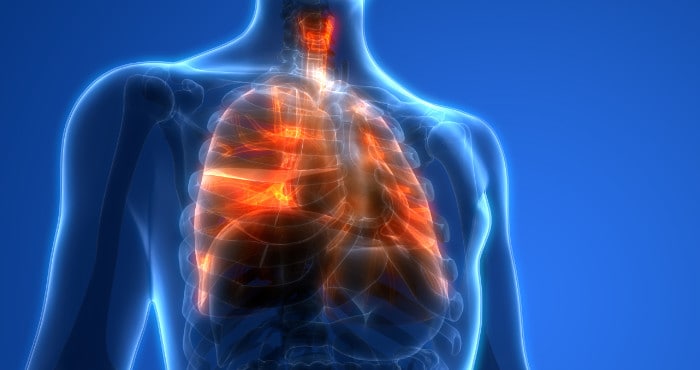
CDC, the U.S. Food and Drug Administration (FDA), state and local health departments, and other clinical and public health partners are investigating a national outbreak of e-cigarette, or vaping, product use-associated lung injury (EVALI).
Overview
- CDC, FDA, and state health authorities have made progress in identifying the cause of EVALI.
- Emergency department (ED) visits related to e-cigarette, or vaping, products continue to decline, after sharply increasing in August 2019 and peaking in September.
- National and state data from patient reports and product sample testing show tetrahydrocannabinol (THC)-containing e-cigarette, or vaping, products, particularly from informal sources like friends, family, or in-person or online dealers, are linked to most EVALI cases and play a major role in the outbreak.
- Vitamin E acetate is strongly linked to the EVALI outbreak. Vitamin E acetate has been found in product samples tested by FDA and state laboratories and in patient lung fluid samples tested by CDC from geographically diverse states. Vitamin E acetate has not been found in the lung fluid of people that do not have EVALI.
- Evidence is not sufficient to rule out the contribution of other chemicals of concern, including chemicals in either THC or non-THC products, in some of the reported EVALI cases.
CDC will continue to update guidance related to EVALI as appropriate.What We Know
About the Outbreak:
- As of February 4, 2020, a total of 2,758 hospitalized EVALI cases or deaths have been reported to CDC from all 50 states, the District of Columbia, and two U.S. territories (Puerto Rico and U.S. Virgin Islands).
- Sixty-four deaths have been confirmed in 28 states and the District of Columbia (as of February 4, 2020).
- Emergency department (ED) visits related to e-cigarette, or vaping, products continue to decline, after sharply increasing in August 2019 and peaking in September.
- National ED data and active case reporting from state health departments around the country show a sharp rise in symptoms or cases of EVALI in August 2019, a peak in September 2019, and a gradual, but persistent decline since then.
- Reasons for the decline are likely multifactorial and may be related to the following:
- Increased public awareness of the risk associated with THC-containing e-cigarette, or vaping, product use as a result of the rapid public health response.
- Removal of vitamin E acetate from some products.
- Law enforcement actions related to illicit products.
- Although cases related to the outbreak are decreasing, new cases continue to be reported to CDC by state health departments and samples connected to EVALI patients continue to be tested by both CDC and FDA.
- Laboratory data show that vitamin E acetate, an additive in some THC-containing e-cigarette, or vaping, products, is strongly linked to the EVALI outbreak.
- A recent studyexternal icon analyzed samples from 51 EVALI cases from 16 states and a comparison group of samples from 99 comparison individuals without EVALI for vitamin E acetate, plant oils, medium chain triglyceride (MCT) oil, coconut oil, petroleum distillates, and diluent terpenes.
- Vitamin E acetate was identified in bronchoalveolar lavage (BAL) fluid samples (fluid samples collected from the lungs) from 48 of the 51 EVALI patients, but not in the BAL fluid from the healthy comparison group.
- No other toxicants were found in BAL fluid from either group, except for coconut oil and limonene (1 EVALI patient each).
What CDC Recommends
- CDC and FDA recommend that people not use THC-containing e-cigarette, or vaping, products, particularly from informal sources like friends, family, or in-person or online dealers.
- Vitamin E acetate should not be added to any e-cigarette, or vaping, products. Additionally, people should not add any other substances not intended by the manufacturer to products, including products purchased through retail establishments.
- Adults using nicotine-containing e-cigarette, or vaping, products as an alternative to cigarettes should not go back to smoking; they should weigh all available information and consider using FDA-approved smoking cessation medicationsexternal icon. If they choose to use e-cigarettes as an alternative to cigarettes, they should completely switch from cigarettes to e-cigarettes and not partake in an extended period of dual use of both products that delays quitting smoking completely. They should contact their healthcare professional if they need help quitting tobacco products, including e-cigarettes, as well as if they have concerns about EVALI.
- E-cigarette, or vaping, products (nicotine- or THC-containing) should never be used by youths, young adults, or women who are pregnant.
- Adults who do not currently use tobacco products should not start using e-cigarette, or vaping, products.
- THC use has been associated with a wide range of health effects, particularly with prolonged frequent use. The best way to avoid potentially harmful effects is to not use THC-containing e-cigarette, or vaping, products.
- Persons engaging in ongoing cannabis use that leads to significant impairment or distress should seek evidence-based treatment by a healthcare professional.
Key Facts about Use of E-Cigarette, or Vaping, Products
- Electronic cigarettes—or e-cigarettes—are also called vapes, e-hookahs, vape pens, tank systems, mods, and electronic nicotine delivery systems (ENDS).
- Using an e-cigarette is commonly called vaping.
- E-cigarettes work by heating a liquid to produce an aerosol that users inhale into their lungs.
- The liquid can contain: nicotine, tetrahydrocannabinol (THC) and cannabinoid (CBD) oils, and other substances, flavorings, and additives. THC is the psychoactive mind-altering compound of marijuana that produces the “high.”
Key Facts about Vitamin E Acetate
- Vitamin E acetate is used as an additive, most notably in THC-containing e-cigarette, or vaping, products.
- Vitamin E is a vitamin found in many foods, including vegetable oils, cereals, meat, fruits, and vegetables. It is also available as a dietary supplement and in many cosmetic products, like skin creams.
- Vitamin E acetate usually does not cause harm when ingested as a vitamin supplement or applied to the skin. However, previous research suggests that when vitamin E acetate is inhaled, it may interfere with normal lung functioning.
Latest Information
- As of December 3, 2019, CDC is only reporting hospitalized EVALI cases and EVALI deaths regardless of hospitalization status. CDC has removed nonhospitalized cases from previously reported case counts. See Public Health Reporting for more information.
- As of February 4, 2020, a total of 2,758 hospitalized e-cigarette, or vaping, product use-associated lung injury (EVALI) cases or deaths have been reported to CDC from 50 states, the District of Columbia, and two U.S. territories (Puerto Rico and U.S. Virgin Islands).
- Sixty-four deaths have been confirmed in 28 states and the District of Columbia (as of February 4, 2020):
- Alabama, California, Connecticut, Delaware, District of Columbia, Florida, Georgia, Illinois, Indiana, Kansas, Kentucky, Louisiana, Massachusetts, Michigan, Minnesota, Mississippi, Missouri, Montana, Nebraska, New Jersey, New York, Oregon, Pennsylvania, Rhode Island, South Carolina, Tennessee, Texas, Utah, and Virginia
- The median age of deceased patients was 51 years and ranged from 15-75 years (as of January 14, 2020).
- More deaths are currently under investigation.
- Among the 2,668 hospitalized EVALI cases or deaths reported to CDC (as of January 14, 2020):
- 66% were male
- The median age of patients was 24 years and ranged from 13–85 years.
- By age group category:
- 15% of patients were under 18 years old;
- 37% of patients were 18 to 24 years old;
- 24% of patients were 25 to 34 years old; and
- 24% of patients were 35 years or older.
- 2,022 hospitalized patients had data on substance use, of whom (as of January 14, 2020):
- 82% reported using THC-containing products; 33% reported exclusive use of THC-containing products.
- 57% reported using nicotine-containing products; 14% reported exclusive use of nicotine-containing products.
- 50% of EVALI patients who reported using THC-containing products provided data on product source (as of January 7, 2020):
- 16% reported acquiring products only from commercial sources (recreational and/or medical dispensaries, vape or smoke shops, stores, and pop-up shops).
- 78% reported acquiring products only from informal sources (family/friends, dealers, online, or other sources).
- 6% reported acquiring products from both commercial and informal sources.
- 54% of EVALI patients who reported using nicotine-containing products provided data on product source (as of January 7, 2020):
- 69% reported acquiring products only from commercial sources.
- 17% reported acquiring products only from informal sources.
- 15% reported acquiring products from both commercial and informal sources.
What CDC is Doing
Public Health Response:
- CDC’s Lung Injury response efforts are committed to:
- Detect new cases and track progress in controlling the outbreak.
- Identify and define the risk factors for EVALI.
- Conduct laboratory testing that can assist with identifying chemicals of concern.
- Communicate actionable recommendations to clinicians, public health professionals, and the general public.
Partnerships:
- CDC continues to work closely with FDA, states, public health partners, and clinicians by providing consultation and technical assistance on communication, health alerts, public outreach, and surveillance.
- CDC continues to communicate with international public health partners. Currently, there is a very small number of similar lung injuries outside the U.S. and not close to the magnitude in the U.S.
Media and Communication:
- CDC is maintaining an EVALI webpage with key messages and updates on case counts, deaths, and resources available to healthcare providers, health departments, and the public.
Laboratory Testing:
- CDC developed guidance documents to assist public health laboratories, healthcare providers, pathologists, and others with specimen collection, storage, and submission to CDC for testing.
- CDC is testing bronchoalveolar lavage (BAL) fluid samples as well as blood or urine samples paired to BAL fluid samples.
- CDC is evaluating autopsy tissue specimens associated with individuals with suspected EVALI. CDC is also evaluating biopsy specimens on a case-by-case basis.
- CDC is conducting aerosol emissions testing of case-associated product samples from e-cigarette, or vaping, products, and e-liquids paired to BAL fluid samples.
For more information and resources for key stakeholders, visit For Healthcare Providers and For State and Local Health Departments. General resources are also available.
